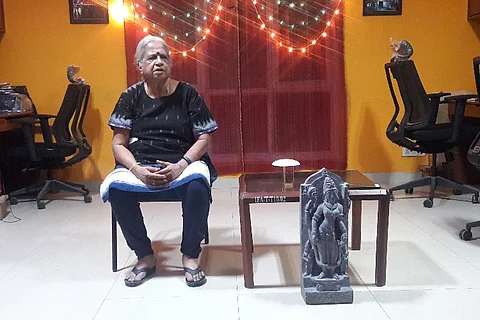

In a room at the Indian Foundation for the Arts in Bengaluru sat a lady in her seventies, dressed in a black cotton kurta, in front of a bright yellow wall festooned with colourful fairy lights. A handful of listeners sat rapt as she talked about her journey as a sculptor.
“The stone inspires me. Once when visiting a temple in Mysuru, I saw the stone sculptures of deities there. That fascinated me. I kept going back to the place almost every day just to see those beautiful sculptures,” says Kanaka Murthy.
Born into a conservative Brahmin family, she grew up in the town of T Narsipur and now resides in Banaswadi, Bengaluru. Sculpting as a profession was not an easy choice for her, given the family she came from and the society she belonged to. But according to her, the main challenge she faced as a budding sculptor was being a woman.
“People refused to believe in my talent since sculpting had always been a male enterprise,” Kanaka says.
Though these biased beliefs discouraged her initially, later they served as an inspiration. Today Kanaka is one of the most celebrated sculptors in India.
When struggling in her career, she received immense help and guidance from the late Devalakunda Vadiraj, her teacher and mentor. Later on, she travelled with him across the country and to many foreign countries, including the UK and Russia, and participated in various sculpting events. From him, Kanaka not only learnt the techniques of sculpting, but also dedication and honesty.
“I graduated in science but felt there was nothing I could do with that degree. I was always inclined towards the arts, listening to music and poetry, and this led the way to my decision in taking up sculpting as a profession,” she says.
Speaking mostly in Kannada, Kanaka says, “I am not interested in learning anything other than sculpting. Not English, not technology, nothing.” Such is her addiction and dedication to stone.
Kanaka’s works are primarily based on Indian mythology. While her sculptures of women have sturdy features, her Ganesha idols exhibit childlike simplicity and credulity. She took inspiration from various periods, including Chalukyan and Hoysala, and combined them to create a fresh style of her own.
Apart from stone, the sculptor has also worked with fibre glass and clay.
“I started with clay modelling and then slowly moved on to sculpting. For portrait making I use fibre glass,” she explains.
In stone, Kanaka works with red stone, white stone and soap stone. She prefers to use traditional tools and techniques.
“I make the tools or choose suitable ones based on what model I will be sculpting,” she says, adding, “It is the tools that, when used carefully, help in carving the best from a stone.”
Kanaka’s notable works include the poet, playwright, novelist and critic Kuvempu’s bust at Lalbagh West Gate; the Wright Brothers’ statue at the Visvesvaraya Industrial and Technological Museum, Bengaluru; busts of Hindustani classical vocalists such as Gangubai Hangal, Mallikajun Mansur and Pandit Bhimsen Joshi in other public places.
Kanaka has been presented with the Karnataka Jakanachari Award, State Shilpakala Academy Award, the Rajyotsava Award and Suvarna Karnataka Award.
She has written two books. One on line drawings called Shilpa Rekha and a memoir titled Howde? Idu Naane, mainly about her mentor, which came out in 2014.
Kanaka says that her daughter Sumathi is also her inspiration. “She is my friend, philosopher and guide. It was she who asked me to document my experiences.” (Editor's note: Sumathi/Rumi Harish is a transgender man and uses he/his pronouns.)
Apart from Kanaka’s graceful presence, a piece of art named “Waghdevi” adorned the room. It was created by Mahadeva, a student of hers. The original sculpture is currently in the Delhi Museum.
When asked about her upcoming art works, Kanaka smiles warmly and says, “My health does not permit it anymore. I cannot sit on the floor. But I am guiding my student and training him. I am trying to pass on all that I have learnt from my guru.”
Concluding her talk, she says, “Always do what you are good at. Society and people will intervene, but if you are determined nothing is unconquerable.”
Note: Changes were made to this story after it was first published to add an Editor's note.